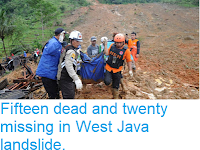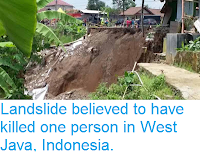Four people have died and another five injured following a landslide in the village of Ciapus in West Java, Indonesia, on Friday 15 February 2019. The incident happened at about 11.00 pm local time, following several hours of heavy rain in the area, undermining a house in which the nine people, all believed to be members of one family, were living. The house then collapsed gown the hillslope causing the deaths and injuries. Landslides are a common problem after severe weather events, as excess
pore water pressure can overcome cohesion in soil and sediments,
allowing them to flow like liquids. Approximately 90% of all landslides
are caused by heavy rainfall. The four people who died have been identified as Nurhayati, 60, Imelda Yanti, 13, Dea Aprilia, 8 and Wildan, 3, while those injured were Saepuloh, 35, Santi Fitri Dewi, 27, Haryanti, 33, Dani, 35, and Septi, nine months. Several nearby properties have been evacuated as a precaution.
Residents of properties in Ciapus, West Java, evacuating their homes following a landslide on 15 February 2019. AFP.
Landslides are a common problem in Java, particularly during the Northeast Monsoon, which lasts from November to February, with peak rainfall in January and February, and can result in an annual
rainfall of around of 4000 mm in parts of Central Java. This problem has been made worse as expanding populations
has led to people farming higher on hillslopes, in an area where soils
tend to be volcanic in action and poorly consolidated (i.e. lack much
cohesion), making them more prone to landslides.
The approximate location of the 15 February 2019 Ciapus landslide. Google Maps.
Monsoons
are tropical sea breezes triggered by heating of the land during the
warmer part of the year (summer). Both the land and sea are warmed by
the Sun, but the land has a lower ability to absorb heat, radiating it
back so that the air above landmasses becomes significantly warmer than
that over the sea, causing the air above the land to rise and drawing in
water from over the sea; since this has also been warmed it carries a
high evaporated water content, and brings with it heavy rainfall. In the
tropical dry season the situation is reversed, as the air over the land
cools more rapidly with the seasons, leading to warmer air over the
sea, and thus breezes moving from the shore to the sea (where air is
rising more rapidly) and a drying of the climate.
Diagrammatic representation of wind and rainfall patterns in a tropical monsoon climate. Geosciences/University of Arizona.
Java has two distinct Monsoon Seasons, with a Northeast Monsoon driven
by winds from the South China Sea that lasts from November to February
and a Southwest Monsoon driven by winds from the southern Indian Ocean from March to October. Such a double Monsoon Season is common
close
to the equator, where the Sun is highest overhead around the equinoxes
and lowest on the horizons around the solstices, making the solstices
the coolest part of the year and the equinoxes the hottest.
The winds that drive the Northeast and Southwest Monsoons in Southeast Asia. Mynewshub.
See also...
Follow Sciency Thoughts on Facebook.










